As the days grow longer and the temperatures start to rise, you should begin seeing more and more signs that spring has arrived - and with it, the hummingbirds! You may live in an area where you find yourself lucky enough to host hummingbirds year-round, but for the rest of us, we reluctantly say goodbye to these little beauties each fall and impatiently await their return in the spring. If you're like us, you find yourself checking the hummingbird migration map daily for sightings in your area. As we watch those little hummingbird icons inch ever closer, below are some quick hummingbird feeder tips to make sure you're ready.

Hummingbird Nectar
The tried and true formula for hummingbird food is simple: about one part white granulated sugar to four parts water. This 20% sugar concentration best mirrors the sugar concentration naturally found in flowers preferred by hummingbirds. Also, the natural sugars found in flower nectar are primarily sucrose, like that of white granulated sugar.
Boil the water for approximately 2 minutes, add the sugar, and stir to dissolve thoroughly. Cover and allow to cool before using or pouring into a clean storage bottle. A large batch of nectar can be made and stored in the refrigerator for up to two weeks. This makes refilling the feeder easy so you won't mind doing it every few days.
Additional suggestions:
- We do NOT recommend adding red food dye or any coloring, whether natural or artificial, to the nectar.
- Make sure to thoroughly clean your feeders before the first use of the season and before each subsequent refill (see below for more on cleaning).
- We only recommend using regular white granulated sugar in nectar preparation.
- Do NOT use honey. Honey is comprised primarily of fructose and glucose and therefore hummingbirds digest this much less efficiently. Also, fermentation and mold growth occurs much more rapidly in nectar solutions using honey than those from granulated sugar.
- Do NOT use artificial sweeteners! Remember, these sweeteners contain no calories, which means they provide no energy to the hummingbirds.
- Higher concentrations of nectar can be used. In fact, offering nectar with higher sugar concentrations early in the season and again in the late summer can help hummingbirds recover from and prepare for migration. (Don't go too overboard though! Studies show that hummingbird nectar concentration preference caps off at about 30% or about 3 parts water to 1 part sugar.)

Cleaning Your Hummingbird Feeder
In order to be a responsible host, you must keep your feeder clean and full of fresh nectar. Every four or five days take down your feeder and discard any unconsumed sugar water. Be aware, in periods of extreme heat (or if you hang your feeder in direct sunlight) the nectar may need to be changed more frequently as the fermentation process can happen quicker. If you notice that the nectar is turning milky, or that white strings or black spots are growing in it, pour the nectar out and clean your feeder immediately.
Take apart your feeder and flush with hot tap water – a little vinegar can be added to the water to help prevent mold from becoming established. Visually inspect the feeder for black mold. If mold is present, place all parts in dishwasher for a thorough cleaning for a glass feeder. For a thorough cleaning on plastic feeders, use a pipe cleaner or small brush when washing the feeder parts by hand with a solution of one part bleach to nine parts hot water, or with a mild solution of unscented dish detergent and warm water. Be sure to rinse thoroughly with water and let dry completely before refilling.
This is where selecting your hummingbird feeders carefully becomes important! Always look for a hummingbird feeder with removable parts to make a thorough cleaning more feasible.
Keeping Your Hummingbird Feeder Full
The need to change the nectar depends on the temperatures, where the feeder is hung, and number and frequency of hummingbirds feeding at your feeder. If the birds are not emptying your feeder between cleanings, it's unnecessary and wasteful to fill it completely. Fill only with the amount of nectar they will consume in a few days. Remember, hummingbirds to not use their beaks as straws for drinking nectar. Rather, they stick their beaks into the feeding port and then extend their tongue into the nectar. A hummingbird's tongue is quite long and has a very different structure than you might think, allowing them to reach rather deep for a drink. Depending on the species of hummingbird (and the individual bird) they will be able to reach pretty far down in a feeder to drink the nectar.
Over time you will get a feel for how much nectar to put in the feeder.

Pictured: Vintage Blossom Decorative Glass Hummingbird Feeder
RELATED ARTICLES
Hummingbird feeder challenges and solutions
10 interesting facts about hummingbird behavior
5 most common hummingbirds of the US & Canada
What colors are hummingbirds attracted to?







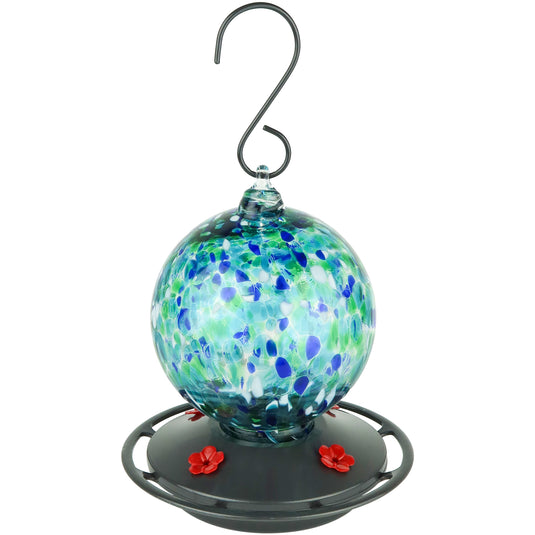






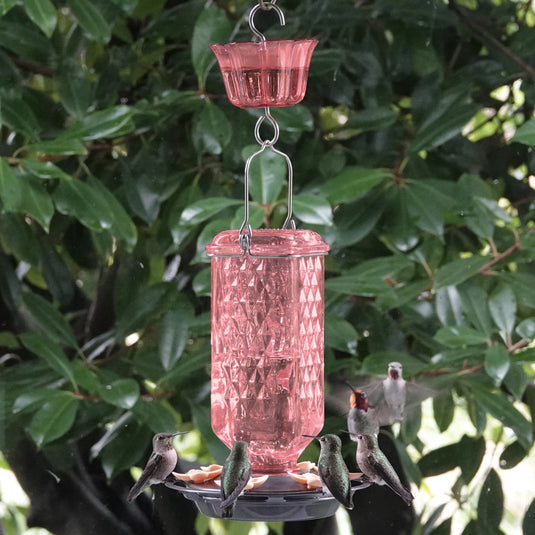
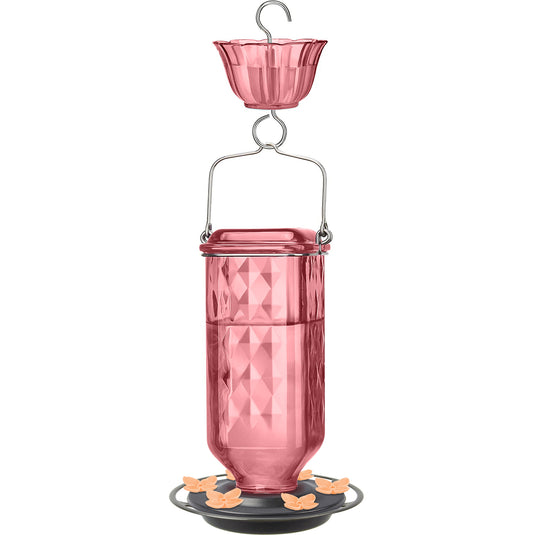


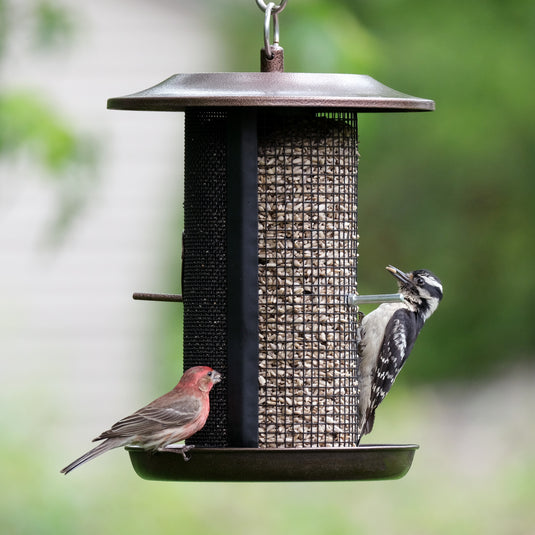



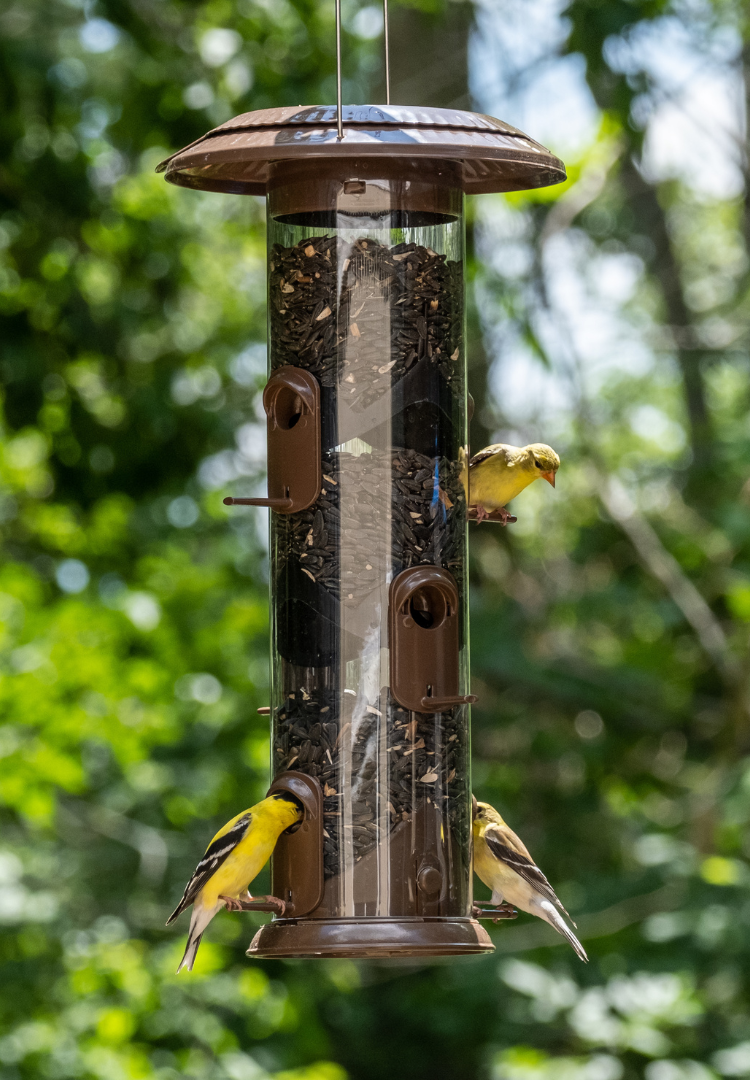
We use the HB feeders that stick to the window also, and ants find it no matter how careful I am. We found a tub of repellent for ants at the Wild Bird shop, and ants hate it. Quickly resolved the ant issue and just takes a small amount on the top of the suction cup after its attached to the window.
Hi Margie,
Thanks for checking in! A few things right off the bat to suggest. First, make sure to regularly clean your feeder if you aren’t already. By ‘regular’ in hummingbird feeder terms we suggest once or twice a week. Another tip is to make sure that no nectar drips when you are hanging your feeder back up. Lastly, if you are located in a hot climate, your water might be evaporating too quickly so you might need to fill it up more often. If you have tried these and still have issues, feel free to email us at info@natureswaybirds.com. Enjoy the hummingbirds!
I have the. hummingbird feeder that stick to glass door and ants keep going in. I fill the water and still don’t know what to do to prevent the ants to go inside of it…Help!!!
We are “newbies” as we just starting feeding our backyard flock this year. The hummers are by far our favorite birds…so beautiful and fun to watch. We love them SO much, and will miss watching them.
Hi Penelope!
I hope your grandmother is getting her fill of the hummingbirds! Here in Ohio there are still plenty visiting our feeders. Yes, we do recommend white sugar when making nectar. The recipe and more information can be found here: https://www.natureswaybirds.com/pages/helpful-tips
Thank you!